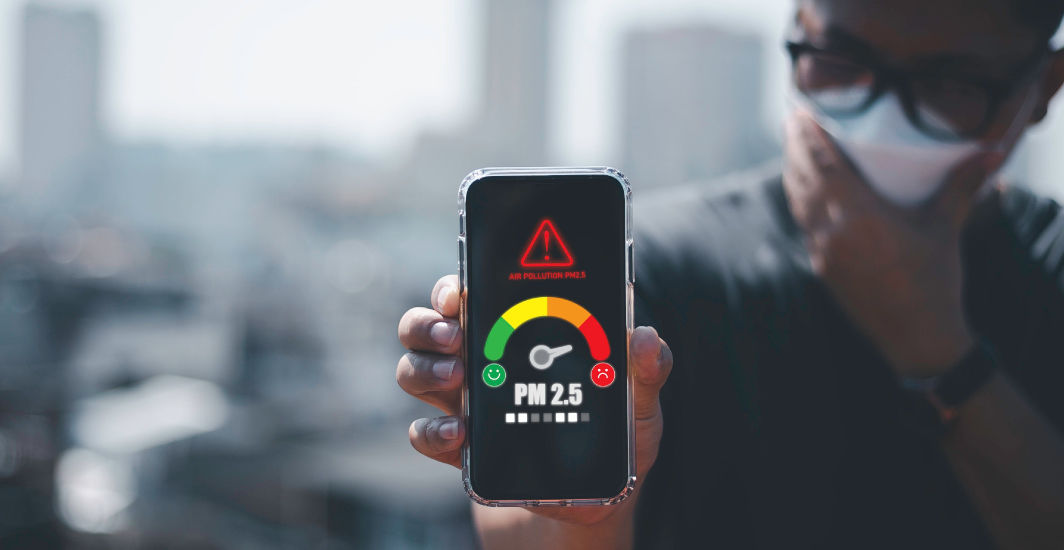General Health
How Does The Air Pollution Monitoring System Work?
By Apollo Pharmacy, Published on- 22 November 2024, Updated on -13 December 2024
Share this article
0
0 like

Air pollution is now acknowledged as a pressing global issue, with severe consequences for both human health and the environment. Prolonged exposure to polluted air, including smog, can significantly impact well-being, leading to conditions such as asthma, respiratory disorders, allergies, and even cancer. In this context, air quality monitoring systems play a crucial role. These systems serve as our first line of defence, enabling us to track, analyse, and mitigate the effects of deteriorating air quality. Continue reading to understand how these systems operate and their contribution to combating air pollution.
Importance of Air Pollution Monitoring
Air quality monitoring offers a clear and real-time understanding of the air we breathe. These systems measure a wide range of pollutants, serving as a valuable resource for governments, researchers, and individuals. By providing actionable data, they help drive policy changes, support scientific advancements, and enable people to make informed lifestyle choices.
For individuals, while it may not be possible to directly improve overall air quality, these systems empower proactive decision-making. By staying informed, you can take measures to reduce exposure to harmful pollutants. For instance, data from these systems can guide you on the best times to use public transport or avoid activities like refuelling your vehicle during high pollution periods. Additionally, the tangible data provided by these systems raises awareness about the severity of air pollution, encouraging collective action and responsibility toward a healthier environment.
Types of Pollutants Measured by Air Pollution Monitoring Systems
Air quality monitoring systems are specifically engineered to detect and measure various air pollutants. They are capable of tracking a wide range of substances, including particulate matter, carbon monoxide (CO), carbon dioxide (CO2), nitrogen oxide (NO), nitrogen dioxide (NO2), sulphur dioxide (SO2), ozone (O3), hydrogen sulphide (H2S), and volatile organic compounds (VOCs). Some advanced systems go beyond pollutant measurement, also capturing meteorological factors like humidity, temperature, and atmospheric pressure. This comprehensive approach provides a deeper insight into the condition of the air around us.
Types of Air Pollution Monitoring Systems
Air quality monitoring devices are available in various types, each tailored to specific purposes and requirements. Common categories include:
- Stationary Monitoring Stations: These systems are fixed in locations such as urban areas, industrial zones, or other high-pollution regions. They continuously monitor air quality and provide real-time data.
- Mobile Monitoring Units: Portable devices designed for temporary use in different areas to assess pollution levels. They are ideal for short-term investigations or targeting specific air quality concerns.
- Indoor Air Quality Monitors: These tools focus on monitoring air quality inside buildings like homes, schools, offices, and hospitals. They detect indoor pollutants such as radon, formaldehyde, and mould spores.
- Remote Sensing Technologies: Utilising satellites or drones, these systems monitor air quality over large regions. They offer valuable insights into pollution trends on a regional or global scale.
Components of Air Pollution Monitoring Systems
Air pollution monitoring systems are designed to measure pollutants and other parameters in the atmosphere, ensuring we maintain air quality standards. These systems typically comprise several key components:
1. Sensors
These are the core elements of monitoring systems. Different sensors detect specific pollutants such as sulphur dioxide, nitrogen dioxide, carbon monoxide, particulate matter, ozone, and volatile organic compounds. Sensors are broadly categorised into:
- Chemical Sensors: Detect and quantify air pollutants.
- Physical Sensors: Measure environmental factors like humidity, temperature, and pressure.
2. Data Acquisition System: This system collects information from the sensors using tools like data loggers or microcontrollers, enabling the analysis of sensor readings.
3. Communication Infrastructure: Data is transmitted to a central hub for analysis through methods like wired connections, cellular networks, Wi-Fi, or satellite systems.
4. Data Processing and Analysis Software: Specialised software processes the collected data, evaluates pollution levels, and generates reports or alerts when levels exceed safety thresholds.
5. Display and Reporting Interface: Processed data is presented to users via mobile apps, websites, or dashboards. It provides real-time updates, historical trends, and critical air quality insights in a user-friendly format.
Types of Sensor Technologies Used in Air Pollution Monitoring Systems
Understanding sensor technologies is essential for choosing an air pollution monitor that meets your specific monitoring needs. Here are the commonly used sensor technologies:
1. Particulate Matter (PM) Sensors: These sensors operate using light scattering principles. A light source is directed at airborne particles, and the degree of scattering helps measure the particle count and concentration. This data provides accurate insights into particulate matter levels.
2. Gas Sensors: Gas sensors employ various technologies, including:
- Semiconductor Sensors: Change resistance in response to different gas levels.
- Electrochemical Sensors: Generate electrical signals proportional to gas concentrations.
- Catalytic Combustion Sensors: Measure heat generated from the combustion of gases.
3. Volatile Organic Compounds (VOC) Sensors: VOC sensors typically rely on photoionisation detection (PID). When ultraviolet (UV) light ionises VOCs, a current is produced, with its magnitude indicating the VOC concentration.
4. Formaldehyde Sensors: These sensors often use electrochemical detection. A chemical reaction occurs, generating a current that corresponds to the formaldehyde level.
5. Acid Vapour Sensors: These sensors use methods like electrochemical detection, absorption spectroscopy, or colourimetric tubes. The choice of technique depends on the specific application and monitoring requirements.
Advantages of Air Pollution Monitoring Systems
Air quality monitoring systems provide numerous benefits for public health and environmental sustainability. Here are the key advantages:
- Early Warning: These systems can quickly detect harmful pollutants, enabling authorities to issue timely warnings and help individuals take necessary precautions.
- Health Protection: Continuous air monitoring identifies areas with poor air quality, safeguarding vulnerable populations such as children, the elderly, and individuals with respiratory conditions.
- Impact Assessment: By tracking pollution from industries and vehicles, these systems assess their effects on the environment, aiding in the development of effective environmental protection measures.
- Policy Support: Reliable data from monitoring systems helps policymakers craft informed regulations, improve urban planning, and manage development projects to mitigate pollution.
- Financial Benefits: Cleaner air reduces healthcare costs and enhances productivity, making cities more appealing to businesses and tourists alike.
Conclusion
Air pollution monitoring systems are indispensable tools in the fight against deteriorating air quality. By offering real-time insights into various pollutants and environmental factors, these systems empower individuals, communities, and policymakers to take informed actions. Whether it’s through early warnings, health safeguards, or guiding policies for sustainable urban planning, these systems play a vital role in protecting public health and the environment. With advancements in technology, their capabilities continue to expand, fostering greater awareness and driving collective efforts toward a cleaner, healthier, and more sustainable future.
General Health
Leave Comment
Recommended for you

General Health
What Are The Symptoms Of Dengue?
Learn about the symptoms, prevention strategies, and treatment options for dengue fever. Stay informed and protect yourself from this mosquito-borne viral disease.

General Health
How Is Shingles Different From Chickenpox?
Explore the contrasts between shingles and chickenpox. Understand their differences in symptoms, causes, and treatments for informed health decisions.

General Health
How To Protect Skin From Air Pollution?
Air pollution significantly impacts the skin, causing oxidative stress and depleting antioxidants, which can lead to premature ageing, acne, and inflammation. Pollutants contribute to skin damage by triggering inflammation and disrupting the skin’s natural defences. This article explores the harmful effects of air pollution on the skin and offers effective strategies to combat them.
Subscribe
Sign up for our free Health Library Daily Newsletter
Get doctor-approved health tips, news, and more.
